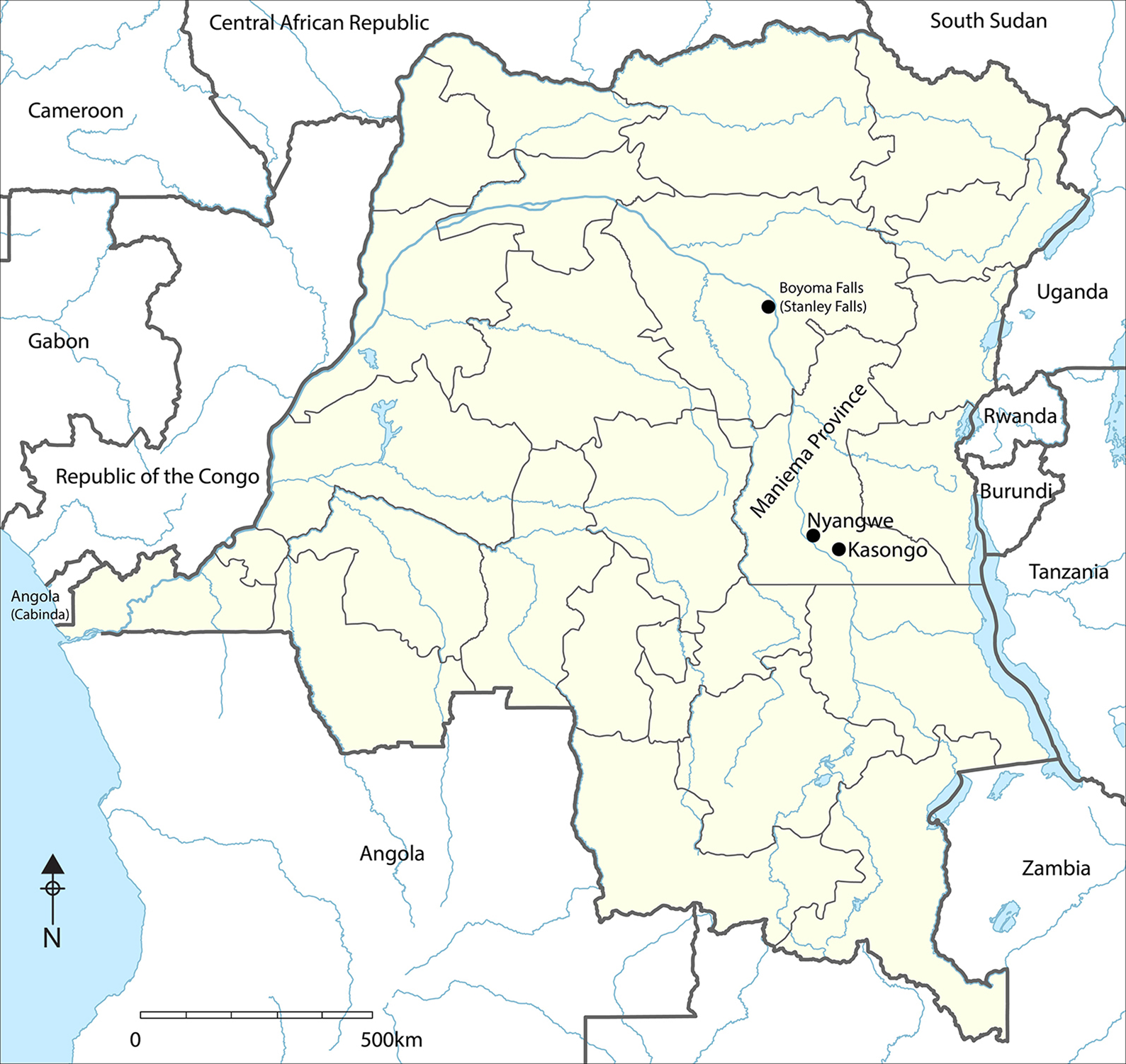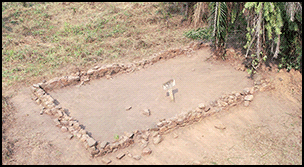Introduction
During the nineteenth century, merchants from the coastal Swahili city-states developed a vast commercial network across Eastern Central Africa. These merchants, generally referred to as Swahili-Arab, were mainly trading in slaves and ivory destined for the Sultanate of Zanzibar as well as the Indian Ocean trade ports (Vernet Reference Vernet and Ness2009). The network consisted of caravan tracks connecting Central Africa with the East African coast, and included a series of strongholds, settlements and markets. As a result of this network, the populations of Eastern Central Africa adopted the customs of the coast such as the Swahili language, coastal dress and the practice of Islam, as well as new agricultural crops and farming techniques. The Swahili-Arab founded important slave and ivory markets, such as those at Kasongo and Nyangwe on the Lualaba (Congo) River (Figure 1).

Figure 1. Map of the Democratic Republic of Congo, showing Maniema Province and the location of Kasongo, Nyangwe and Boyoma Falls (the former Stanley Falls of the Congo Free State and the Belgian Congo) (map adapted from Karte: NordNordWest, Lizenz: Creative Commons by-sa-3.0 de).
Kasongo was a strategic and commercial crossroads. One of the most notorious slave traders from Zanzibar—widely known by his pseudonym, Tippo Tip—made Kasongo the capital of his commercial domain in 1875 (Renault Reference Renault1987). His influence was such that he became the Governor of Stanley Falls under the rule of King Leopold II. The alliance between Tippo and Leopold's state, was, however, short-lived. The Berlin Conference and the antislavery campaign (c. 1880s–1890s) led to what became known as the Arab Campaign or Congo-Arab War between the troops of Leopold, and the Swahili-Arab and their allies (Marechal Reference Marechal1992). Following the colonial troops’ victory in 1894, the Congo Free State—under Leopold—endeavoured to erase the traces of Swahili-Arab influence (Ceulemans Reference Ceulemans1959), while using anti-slavery propaganda to justify his ambitions to dominate the whole Congo basin.
Swahili-Arab cultural heritage in Maniema
The history of the Swahili-Arab in the Congo, as currently understood, is based mainly on European primary and secondary textual sources. Many of them can be found at the African Archives of the Belgian Ministry of Foreign Affairs and the Royal Museum of Central Africa (RMCA). Swahili texts, written in Arabic, are another important historical source (Luffin Reference Luffin2007). As rich and well documented as the establishment of the Swahili-Arab network in East Central Africa is however, our view of this period is very restricted, and perhaps biased, as there are no sources that record the involvement of local people in the events that transpired during the second half of the nineteenth century.
A preliminary investigation was carried out in the Maniema Province in 2016; the objective was to outline, for the first time, a chrono-cultural sequence for this undocumented area (Champion et al. Reference Champion, Arazi, Mambu, Luna, Cornelissen and Livingstone Smith2017). It also was an occasion to visit, inter alia, the historical sites of Nyangwe and Kasongo. Despite their cultural and historical significance, these sites have never received any kind of protection or preservation measures, nor have they been the subject of archaeological investigations.
Under the coordination of Groundworks, a non-profit organisation that focuses on cultural heritage documentation and preservation in Africa, a network of Congolese and Belgian institutions has been able to secure funding to initiate scientific research and protection measures for the legacy of the Swahili-Arab in this part of Central Africa. Project partners include the Institut des Musées Nationaux du Congo, the RMCA and the Universities of Kinshasa and Lubumbashi. The project, ‘The Archaeology and Oral History of Slavery in the Maniema Province’, was launched at the beginning of 2018.
Methodology
The project combines archaeological surveys and excavations with the collection of oral histories and memories, participant observation, archival research and recent anthropological and historical scholarship. In line with current notions that cultural heritage preservation needs to be an inclusive practice (Apaydin Reference Apaydin and Apaydin2018) and dialogic process (Harrison Reference Harrison2013), the project attempts to merge local knowledge, scientific research methods and contemporary photography. Indeed, the history of the Swahili-Arab in the eastern Congo, which overlapped with imperial exploration and colonial expansionism, has left a palimpsest of cultural landscapes, texts, images, stories, songs and objects that both need and deserve to be considered from multiple perspectives in order to create a nuanced narrative of the events.
Archival records
Most of our knowledge of Central Africa during the nineteenth century is based on textual sources. They include the accounts of imperial explorers such as David Livingstone, Verney Lovett Cameron and Henry Morton Stanley, who passed through the Maniema on their travels through Central Africa. There are also the reports of colonial agents as well as the writings of adventurers, journalists and missionaries. An important photographic collection is housed at the RMCA, which dates from the end of the nineteenth century to the mid twentieth century and includes, for example, rare pictures of Arab dwellings in Kasongo taken in 1892, along with portraits and group photos of the Swahili-Arab.
Fieldwork
Archaeological surveys and excavations focused on a site believed to have been the former settlement of the Swahili-Arab merchants in Kasongo, and its immediate hinterland. Material was collected from ploughed fields or erosion surfaces such as tracks, gullies, riverbanks and village surfaces. Standard 1 × 1m or 1 × 2m test pits were opened in key locations and excavated in spits of 100mm (Figure 2). All material was sieved to 5mm. Besides corroborating the position of Old Kasongo, or Tongoni as it is called in Swahili, the 2018 fieldwork attested to topographic anomalies in the form of a series of large, purpose-built platform areas, on which the residences of the Arab merchants were built. These platforms could also act as defensive structures (Figure 3). In 2019 further excavations were carried out at Tongoni, and a drone survey was undertaken to create a topographic image and a 3D rendition of the site.

Figure 2. Igor Matonda excavating the foundations of house B in Tongoni (photograph by G. Senga).

Figure 3. Drone image of the remains of Tippo Tip's house (10.9 × 6.6m), showing its location on a platform area (photograph by A.L. Smith & N. Arazi).
Interviews
After conducting a desktop assessment of the region's cultural history, we developed a protocol for conducting interviews with people from the various ethnic groups living in the modern administrative territory of Kasongo. The purpose is to collate local perspectives on the history and legacy of the Swahili-Arab in Maniema and record the stories that have been passed down through generations (Figure 4). The project also identified and catalogued sites that are of historical importance for resident communities such as refuge camps, sacred places and sites of battles or massacres.

Figure 4. Hawa Mayuma, resident of Kasongo's Muslim district, known as Quartier 18 (photograph by G. Senga).
This project constitutes the first attempt to combine archaeological investigations with oral history and archival data on the Swahili-Arab legacy in the DRC. Our objective is to expose a rich and diverse cultural heritage that has previously been marginalised, and to recover the shared history of the DRC and Belgium that has long been tainted by colonial propaganda.
Acknowledgements
We thank the Gerda Henkel Foundation for their generous support. At the RMCA we extend our thanks to Els Cornelissen, Guido Gryseels and the Geology Department for the use of their drone. We also thank Paul Bakwalufu (Director of the IMNC), Augustin Musafiri Myoma (Governor of the Maniema Province), Kingombe Kitenge Benoit (Kasongo's Territorial Administrator), Jean Sumaili (Rector of the University of Kindu) and Marie-France Mombaerts. Our work would not have been possible without the participation of Bertin Mukali, Gaston Tambwe, Alphani Amadi, Abedi Amuri Papy, Roger Tabala Wane, Abdul Mwanandeka Salum, Richard Lutipa, Gilbert Salumu, Kapaya Mwanga, Maisha, Luguzi and Martien Shabani, and Ozile and Frederic Kitwanga.







